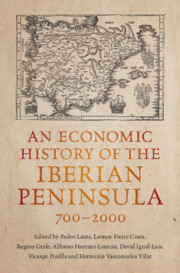Book contents
- An Economic History of the Iberian Peninsula, 700–2000
- An Economic History of the Iberian Peninsula, 700–2000
- Copyright page
- Contents
- Figures
- Tables
- Contributors
- Preface: By Way of Presentation
- Introduction
- Part I The Making of Iberia, 700–1500
- Part II Globalization and Enlightenment, 1500–1800
- Part III Industrialization and Catching Up, 1800–2000
- 18 Economic Growth and the Spatial Distribution of Income, 1800–2000
- 19 Population Growth, Composition and Educational Levels
- 20 Economic Policies and Institutions
- 21 Iberian Financial System, 1800–2000
- 22 Economic Growth and Structural Change in the Iberian Economies, 1800–2000
- 23 Living Standards in Iberia, 1800–2010
- 24 Iberian Globalization and Catching Up in the Poor South European Periphery, 1830–2010
- 25 The Iberian Economy in Comparative Perspective, 1800–2000
- References
- Index
19 - Population Growth, Composition and Educational Levels
from Part III - Industrialization and Catching Up, 1800–2000
Published online by Cambridge University Press: 22 February 2024
- An Economic History of the Iberian Peninsula, 700–2000
- An Economic History of the Iberian Peninsula, 700–2000
- Copyright page
- Contents
- Figures
- Tables
- Contributors
- Preface: By Way of Presentation
- Introduction
- Part I The Making of Iberia, 700–1500
- Part II Globalization and Enlightenment, 1500–1800
- Part III Industrialization and Catching Up, 1800–2000
- 18 Economic Growth and the Spatial Distribution of Income, 1800–2000
- 19 Population Growth, Composition and Educational Levels
- 20 Economic Policies and Institutions
- 21 Iberian Financial System, 1800–2000
- 22 Economic Growth and Structural Change in the Iberian Economies, 1800–2000
- 23 Living Standards in Iberia, 1800–2010
- 24 Iberian Globalization and Catching Up in the Poor South European Periphery, 1830–2010
- 25 The Iberian Economy in Comparative Perspective, 1800–2000
- References
- Index
Summary
This chapter presents the evolution of the main demographic variables: population growth and its sources, occupational structure, territorial distribution, and educational levels. Each of these four variables are taken separately to provide a long-run, quantitative description and an analysis based on bibliography. The overall image resulting from overlaps and interactions between the variables suggests three distinct “structural periods”. The first period, which covers most of the nineteenth century, featured remarkably stable structures. In contrast, the second period, from around 1890 to 1980, was an era of major transformations, such as the demographic transition, de-agrarianization, urbanization and mass literacy. After 1980 a third period is found in which demographic change has shifted to a different path involving low population growth, tertiarization, new trends in population geography, and longer schooling periods. The new challenges associated with this last period call for active public policies.
Keywords
- Type
- Chapter
- Information
- An Economic History of the Iberian Peninsula, 700–2000 , pp. 496 - 518Publisher: Cambridge University PressPrint publication year: 2024



